Radiologia Brasileira - Publicação Científica Oficial do Colégio Brasileiro de Radiologia
AMB - Associação Médica Brasileira CNA - Comissão Nacional de Acreditação
 Vol. 45 nº 2 - Mar. / Apr. of 2012
Vol. 45 nº 2 - Mar. / Apr. of 2012
|
ORIGINAL ARTICLE
|
|
Volume corrections factors in the measurement of 99mTc and 123I activities in radionuclide calibrators |
|
|
Autho(rs): Amanda Ribeiro Correia1; Akira Iwahara2; Luiz Tauhata3; Eduarda Alexandre Rezende1; Tainá Olivieri Chaves4; Antonio Eduardo de Oliveira5; Estela Maria de Oliveira5 |
|
|
Keywords: Radionuclides calibrator; Nuclear medicine; Activity; Tc-99m; I-123. |
|
|
Abstract: INTRODUCTION
In nuclear medicine, the activity of a radiopharmaceutical must be measured with high accuracy in order to achieve the diagnostic or treatment objectives and, at the same time, minimize the dose to the patient, according to the basic principle of optimization in radioprotection. The regulating agencies have established the accuracy limits for activity measurements in nuclear medicine procedures. In Brazil, the Comissão Nacional de Energia Nuclear (CNEN)(1) (Brazilian Nuclear Energy Commission) has established the limit of ±10% for accuracy in radiopharmaceuticals activity measurements in radionuclide calibrators (also known as curiometer or dose calibrator), while the International Atomic Energy Agency (IAEA) has established ±2% for Secondary Standards Radioactivity Laboratories and ±5% for other laboratories( 2). In order to determine the activity value in the calibrator, nuclear medicine services utilize different types of vials. The most utilized ones are the glass vials or plastic syringes with different radiopharmaceutical volumes. The differences in volume, geometry and composition require correction of the original calibration factors of the calibrators. This matter has been the object of studies and discussion by several authors in the literature(3–5). Normally, a radiopharmaceutical contained in a glass vial has its activity measured in a calibrator before being administered to a patient. Later, an aliquot of such radiopharmaceutical is transferred to a plastic syringe and its activity is measured by utilizing the same calibration factor. This later value is considered as being the activity administered to the patient. Thus the radioactive fluid is manipulated in different vials, with different geometries, volumes and compositions. If such differences are not taken into consideration and their correction factors are not previously determined for correction of the activity read on the calibrator, the patient will probably be administered an incorrect activity. The objective of the present study is to determine the correction factors that should be utilized for a correct activity measurement on calibrator of radionuclides originated from the volumetric variation of 99mTc and 123I radiopharmaceuticals contained in 3 and 5 mL plastic syringes. MATERIALS AND METHODS In the present study, the volume correction factors were determined with basis on practical measurements of the response (activity) variation of the radionuclide calibrator with the solution volume in the vial. Two 3 and 5 mL BD Plastipak type plastic syringes (Becton, Dickinson and Company; São Paulo, SP, Brazil) were selected for the study. Such models were selected because they are widely utilized in nuclear medicine services in Rio de Janeiro. The 10R Schott type 1+ glass vials were also selected for being widely utilized by radiopharmaceuticals suppliers and radionuclide calibrator manufacturers(6,7). The 99mTc sources were supplied by the Instituto de Pesquisas Energéticas e Nucleares (IPEN), São Paulo, SP, Brazil, and the 123I sources, by the Instituto de Energia Nuclear (IEN), Rio de Janeiro, RJ, Brazil. Measurements were performed in three radionuclide calibrators: two with ionization chamber (IC) as detectors and the third, equipped with a Geiger-Müller detector (G-M). The 5 mL syringe and the 10R vial were initially filled with 1 mL of 99mTc solution and the activity was measured with the three calibrators. Subsequently, successive additions 1 mL of distilled water and new measurements were made until 5 mL were completed. The same procedure was repeated with the 3 mL syringe, but with an initial volume of 0.5 mL and successive additions of 0.5 mL of distilled water until 3 mL were completed. The procedure was the same for 123I. In order to test the radionuclide calibrators' performances, the 99mTc and 123I solutions contained in 3 and 5 mL syringes were utilized for comparing the activities measured with the calibrators in nuclear medicine services with the activities measured according to the standard reference systems of Laboratório Nacional de Metrologia das Radiações Ionizantes (LNMRI) (Brazilian Laboratory of Ionizing Radiation Metrology). The comparison criteria adopted for the performance analysis is the accuracy limit of ± 10% established by CNEN, i.e., the R ratio of A activity measured by a nuclear medicine service, for the A0 activity measured by LNMRI, adopted as a reference, which must be within the 0.90 < R < 1.10 interval in order for the performance to be considered acceptable. RESULTS Figures 1 and 2 demonstrate the volumetric variation results with the activity obtained for 99mTc measured with 3 and 5 mL syringes, respectively, with three different radionuclide calibrators: Capintec CRC-15R, Veccsa Vexcal and Victoreen Cal-Rad 34-061. The first two calibrators utilize ICs while the third utilizes a G-M detector. Figures 3 and 4 demonstrate the results for 123I. The A0 activity at a normalization volume V0 was utilized for denominating the graphical representation of the activity A versus the individual volume V. For the 5 mL syringe, the V0 was 1 mL, while for the 3 mL syringe the V0 was 0.5 mL. Such data were utilized to obtain the ratio between A/A0 versus V and a second degree polynomial equation was utilized as the best approach for determining the correction factors, as follows: A/A0 = aV2 + bV + c 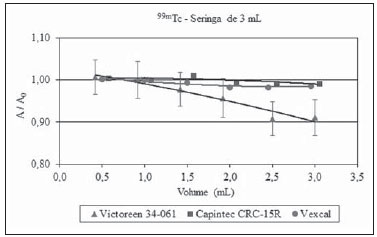 Figure 1. Variation of the activity readings of a 99mTc solution with radionuclide calibrators as a function of volume variation in a 3 mL plastic syringe. 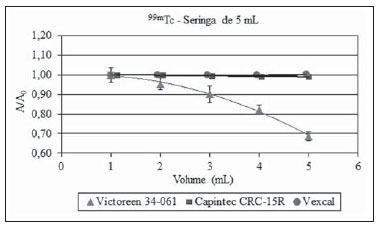 Figure 2. Variation of the activity readings of a 99mTc solution with radionuclide calibrators as a function of volume variation in a 5 mL plastic syringe. 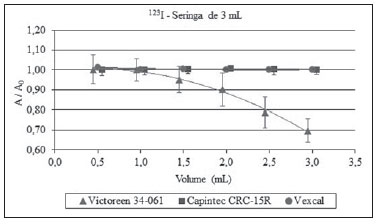 Figure 3. Variation of the activity readings of a 123I solution with radionuclide calibrators as a function of volume variation in a 3 mL plastic syringe 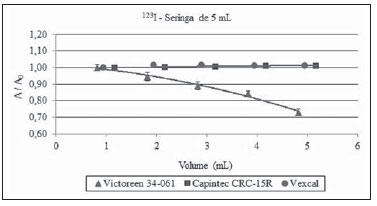 Figure 4. Variation of the activity readings of a 123I solution with radionuclide calibrators as a function of volume variation in a 5 mL plastic syringe. where: A0 is the activity corresponding to the normalization volume V0 and A is the activity measured in an individual volume V. Tables 1 and 2 show the coefficients of the volume correction factors for 99mTc and 123I, respectively in the 3 and 5 mL syringes and the 10R vial. Such coefficients represent the volumetric correction factors for obtaining the correct activity as the volume of the radioactive solution contained in the syringe is varied. 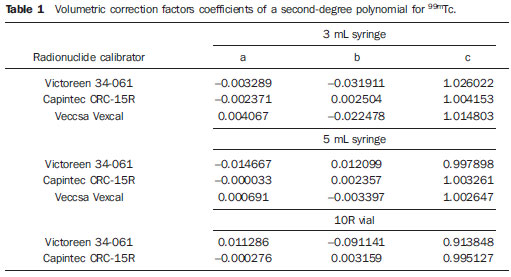 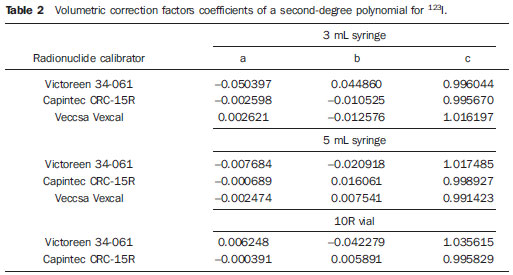 Plastic 3 and 5 mL syringes containing 1 mL of 99mTc and 123I with known activities were utilized to evaluate the performance of different types of radionuclide calibrators. Eight calibrators from several nuclear medicine services in the city of Rio de Janeiro participated in this performance testing, and the results analysis was based on accuracy criterion established by the CNEN Standard NN-3.05. Figures 5 and 6 show the results of this performance test for 3 and 5 mL syringes with 99mTc and 123I, respectively. Each experimental point is the result of five repetitive measurements with the radionuclide calibrators, and the uncertainty bars correspond to the standard deviation of such measurements. 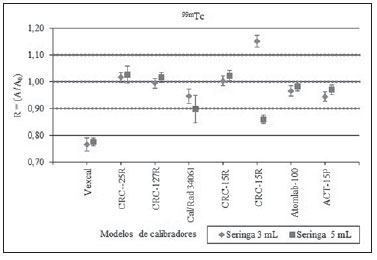 Figure 5. Performance of the calibrators in the measurement of 99mTc in terms of R ratio, according to Standard CNEN NN-3.05. The performance is considered satisfactory (or compliant) when 0.90 < R < 1.10.  Figure 6. Performance of the calibrators in the measurement of 123I in terms of R ratio according to Standard CNEN NN- 3.05. The performance is considered satisfactory (or compliant) when 0.90 <R <1.10. DISCUSSION For the 3 mL syringe with 99mTc, the volume variation from 1 to 3 mL did not cause significant change in the activity measured with the Capintec and Vexcal calibrators. However the measurements with the Victoreen model presented with greater variation, reaching a value 10% lower when the volume increases from 1 to 3 mL. The same behavior was observed for the 5 mL syringe with the two calibrators with ICs, but the Victoreen model presented greater volumetric dependence, with a result 30% lower for the 5 mL volume as compared with the 1 mL initial volume. In the 10R vial, also there was no significant variation in the measurements with the Capintec calibrator, and the variations with the Victoreen model were higher as compared with those observed in the measurements in the syringes, according to coefficients presented on Table 1. However, in this case, there was a reversal in the tendency towards activity decrease with the increase in volume, with an approximately 10% higher result when the volume is increased from 1 to 5 mL. On Table 1, one can observe that the a and b coefficients are lower for the calibrators equipped with ICs utilized in the present study as compared with the one equipped with G-M detector, and the c coefficient is closer to 1 for those equipped with ICs, confirming the lower volumetric dependence of the first ones in relation to the latter one. Such a tendency is also confirmed for 123I, as shown on Table 2. The behavior for 123I is similar to that for 99mTc in the three calibrator models. Again, a higher variation was observed with the Victoreen model, in which the measured activities in the 3 and 5 mL syringes were 70% lower for both syringes, as compared with the activity of the initial volume of 1 mL. Such a greater variation in comparison with 99mTc can be explained by the high absorption in the sample itself of numerous X-rays typical of low energy (27 to 32 keV, with approximately 87% probability of emission)(8) emitted by 123I, which contribute for producing the activity shown on the calibrator reading. The absorption is lower for 99mTc, which preferably emits 140 keV gamma rays. Such effects may also be observed on the uncertainty bars, representing the repeatability of experimental data measurements that are many times greater with the Victoreen model than in the Capintec one. In the case of the 10R vial, the tendency towards activity decrease was maintained with the increase in volume. However, the lowest activity was measured on an intermediate volume of 3 mL, and then increasing, demonstrating a contradictory behavior. New measurements must be performed both for 123I and 99mTc to confirm such unexpected results. The volumetric correction factor coefficients presented on Tables 1 and 2 are valid only for the calibrators, types of vials and radionuclides utilized in the present study, as well as for the studied volumetric ranges. The calibrator owners should determine their own correction factors for each type of vial and radionuclide, with the different volumes routinely utilized in their activities. In the evaluation of the eight calibrator's performance in the measurement of 99mTc activity, the authors have observed a similar behavior for 3 and 5 mL syringes. Amongst the eight tested calibrators, with 16 results, only two with four results were out of the accuracy limits required by the Brazilian standard, presenting a good overall performance. The exception was one of the CRC-15R models, which presented a contradictory behavior as compared with the others (deviation of +15% for the 3 mL syringe and –15% for the 5 mL syringe), requiring new measurements for confirmation of such results. In the case of 123I, only four calibrators were evaluated, as some of them were out of service or were not calibrated for 123I measurements at the time the present study development. One half of the results were out of the accuracy limits of ±10%, with maximum deviation of approximately +30%, while for 99mTc the maximum deviation was -20%. More robust conclusions regarding the performance cannot be generalized, since for that purpose the comparison should comprise all nuclear medicine services which utilize 99mTc and 123I in their routine activities. CONCLUSIONS The results of the present study confirm that the radionuclide calibrator responses depend on the volume, type of vial, and the radionuclide utilized in the measurement, with more critical results with the calibrators utilizing G-M detectors analyzed in the present study, reaching deviations of up to 70% lower as compared with the standard volume. In the performance testing, the maximum deviations were similar for both radionuclides. In order to obtain more robust conclusion on activity measurements in the syringes, the number of elements in the comparison should be higher, particularly for 123I. As nuclear medicine services utilize different types of vials with variable volumes of radiopharmaceuticals, the correction factors required for correct activities administration, must be determined for each calibrator and radionuclide, with the objective of minimizing the administration of unnecessary doses to patients. There is no universal correction factor for each calibrator model and make. Considering that the correct measurement of activity administered to the patient is a relevant part of a nuclear medicine procedure, it is recommended that the regulating agency CNEN intensifies its inspections of nuclear medicine services to verify their compliance with the Standard NN-3.05 requirements. Another recommendation would be for a gradual replacement of calibrators equipped with G-M detectors because of their poor performance, requiring more corrections, as demonstrated by the present study as well as by other studies previously published by the authors(9–12). The present study neither endorse nor divulge any radionuclide calibrator model, but is limited to a description of the results obtained with the studied calibrators. Acknowledgements To IPEN/São Paulo and IEN/Rio de Janeiro, for providing the radioactive sources utilized in the present study. REFERENCES 1. Comissão Nacional de Energia Nuclear. CNEN NN-3.05. Requisitos de radioproteção e segurança para serviços de medicina nuclear. Resolução CNEN-10/96. Brasília, DF: Diário Oficial da União, 19 de abril de 1996. 2. International Atomic Energy Agency. Quality assurance for radioactivity measurement in nuclear medicine. Technical Reports Series no. 454. Vienna: International Atomic Energy Agency; 2006. 3. Tyler DK, Baker M, Woods MJ. NPL secondary standard radionuclide calibrator. Syringe calibration factors for radionuclide used in nuclear medicine. National Physical Laboratory. Appl Radiat Isot. 2002;56:343–7. 4. Baker M. Calibration of the NPL secondary standard radionuclide calibrator for the new 10R Schott, type 1+ vials. Appl Radiat Isot. 2005;63:71–7. 5. Ceccatelli A, Benassi M, D'Andrea M, et al. Experimental determination of calibration settings of a commercially available radionuclide calibrator for various clinical measurement geometries and radionuclides. Appl Radiat Isot. 2007;65:120–5. 6. International Organization for Standardization. ISO 8362-2003. Injection containers and accessories – Part 1: Injection vials made of glass tubing. Geneva: International Organization for Standardization; 2003. 7. Schott Pharmaceutical Packaging. Ampolas feitas de vidro. [acessado em 4 de abril de 2012}. Disponível em: http://schott.com/pharmaceutical_packaging/portuguese/produts/ampoules.html. 8. Chisté V, Bé MM. Table de radionucléides. 123I. [acessado em 4 de abril de 2012]. Disponível em: http://www.necleide.org/DDEP_WG/Nuclides/I-123_tables.pdf. 9. Iwahara A, de Oliveira AE, Tauhata L, et al. Intercomparison of 131I and 99mTc activity measurements in Brazilian nuclear medicine services. Appl Radiat Isot. 2001;54:489–96. 10. Iwahara A, de Oliveira AE, Tauhata L, et al. Performance of dose calibrators in Brazilian hospitals for activity measurements. Appl Radiat Isot. 2002;56:361–7. 11. dos Santos JA, Iwahara A, de Oliveira AE, et al. National intercomparison program for radiopharmaceutical activity measurements. Appl Radiat Isot. 2004;60:523–7. 12. Iwahara A, Tauhata L, de Oliveira AE, et al. Proficiency test for radioactivity measurements in nuclear medicine. J Radioanal Nucl Chem. 2009;281:3–6. 1. M.Sc., CNPq Fellows PhD degree, Course of Nuclear Engineering of the Coordination for the Program of Post-graduation in Engineering, Universidade Federal do Rio de Janeiro (COPPE/ UFRJ), Rio de Janeiro, RJ, Brazil. 2. D.Sc., Researcher at Instituto de Radioproteção e Dosimetria / Comissão Nacional de Energia Nuclear (IRD/CNEN), Rio de Janeiro, RJ, Brazil. 3. D.Sc., Fellow, Visiting Faculty Emeritus, Fundação de Amparo à Pesquisa do Estado do Rio de Janeiro (Faperj), Rio de Janeiro, RJ, Brazil. 4. M.Sc., Researcher, Fundação Oswaldo Cruz (Fiocruz), Rio de Janeiro, RJ, Brazil. 5. M.Sc., Researchers, Instituto de Radioproteção e Dosimetria / Comissão Nacional de Energia Nuclear (IRD/CNEN), Rio de Janeiro, RJ, Brazil. Mailing Address: Dr. Akira Iwahara Instituto de Radioproteção e Dosimetria Avenida Salvador Allende, s/nº, Jacarepaguá Rio de Janeiro, RJ, Brazil, 22780-160 E-mail: iwahara@ird.gov.br Received December 13, 2011. Accepted after revision March 26, 2012. |
|
Av. Paulista, 37 - 7° andar - Conj. 71 - CEP 01311-902 - São Paulo - SP - Brazil - Phone: (11) 3372-4544 - Fax: (11) 3372-4554